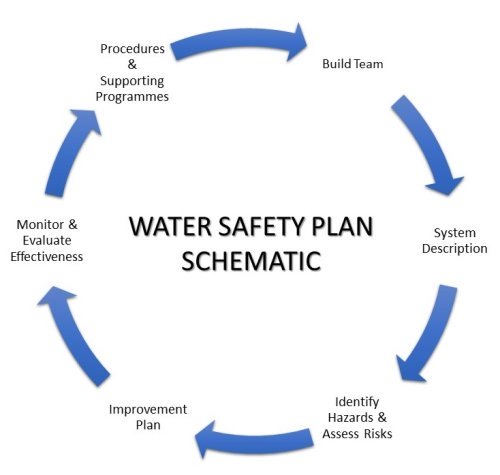
Blog
Water Safety Plan for Ingredient Water
What is a Water Safety Plan ?
A Water Safety Plan (WSP) is a document that outlines the steps a facility or organisation SHOULD take to ensure the optimal operation of its water supply or wastewater infrastructure. It is a proactive approach to identify and control potential hazards and risks that may affect the quality of either the process water or effluent water. The document details the procedures and protocols that are required to a fit-for-purpose water infrastructure should be developed and implemented in accordance with local applicable laws and regulations.

FIG. 1: SCHEMATIC OF THE COFTEC WATER SAFETY PLAN PROCESS
What is Ingredient Water?
Ingredient water is a purified form of water that is used for a variety of applications across several industries. Purified or ingredient water is used in the pharmaceutical industry for products such as injections, syrups, and oral solutions. This water is carefully treated to remove impurities that may interfere with the effectiveness and stability of the final product. The water is usually produced through a multi-step process and is also subjected to stringent quality control tests to ensure that it meets the standards set by regulatory bodies such as the European Pharmacopeia (EP).
In the food industry, cosmetics production, and in a multitude of other markets that produce various products there are similar requirements for high-quality, purified water. These requirements to ensure that the water used in the production process meets necessary standards for safety and consistency in the finished product. These measures are important to maintain the integrity and reputation of the products and the industries that produce them.
Water Safety Plan for Ingredient Water
A water safety plan for ingredient water should focus on the following key elements:
- Source management: Identifying and evaluating the sources of ingredient water and implementing measures to protect them from contamination.
- Monitoring and testing: Regularly monitoring and testing the ingredient water for physical, chemical, and microbiological parameters to ensure it meets the relevant quality standards.
- Treatment: Implementing appropriate treatment processes to ensure the ingredient water meets the relevant quality standards.
- Risk management: Identifying and assessing potential hazards and implementing measures to control or mitigate them.
- Emergency response: Developing and practicing an emergency response plan to address potential water quality issues.
- Communication and training: Communicating the WSP to relevant stakeholders and providing training to staff on the proper implementation and management of the WSP.
- Continuous improvement: Continuously reviewing and improving the WSP based on monitoring and testing results, changes in regulations, and new information on water safety
Summary
To ensure its effectiveness, it is crucial to regularly review and update the WSP in response to changes in the environment, regulations, or company practices. This will help to ensure that the WSP remains relevant and up-to-date. By implementing a WSP, industrial facilities can demonstrate their commitment to protecting water resources and avoiding legal liabilities and reputational risks. It also provides a framework for ensuring that water management practices are consistent and effective, thereby reducing the risk of water pollution and ensuring the safety of process water. In conclusion, a WSP is an essential tool for managing water risk and promoting sustainability in the industrial sector.
Contact us if you would like more information on our water safety plan service or to discuss how this tool can help your business.




